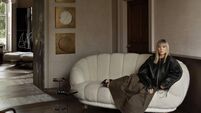Clever home touches on a an even more clever budget

Whether you live in rented accommodation or a starter home, a new book says you can apply your own style on a budget, writes
A wise person once said to me, “bloom where you’re planted”.
It’s a maxim for anyone in a new gaff, with a mortgage the size of Greece’s national debt, or paying a breathtaking rent for squeezing into what the estate agent termed a bijou apartment, but is slightly roomier than a kennel.

The good news is it can be transformed into the home you want, according to a new book by Joanna Thornhill.
Written with the cash-short, ideas-strapped home interiors enthusiast in mind, who wants to put a personal mark on a first home of their own, it’s also for a renter who wants to do a substantial styling project but has to work within the landlord’s parameters.
Let’s face it, these days most people will have experienced what it’s like to have to deal with double-checking before painting the walls and reconsidering every picture hook before hammering.
So, the tips at the beginning of the book are worth studying as they offer advice about communication with your landlord and how to build up a rapport if you are planning to spend several years in the accommodation.
A good co-operative relationship can make the difference between living with a dodgy paint colour and choosing your own, sometimes, better taste, or being able to request moving out their furniture to replace it with some of your own.

Throughout the chapters, though, no matter what she recommends, from storage ideas to hanging art, she includes a section called ‘Renter’s Alternative’ so, for example, if you’re not allowed to hammer a nail in the wall, she has a workable solution.
Tackling an interior can feel like a burden rather than a pleasure, especially if you’re scant on ideas and time-pressed, so there’s value in the easy, quick fix aspect of the book.
If you’re planning to move on quickly and are just waiting for the right place to become available, do weigh up spending on it against living in a place that is dispiriting.
Even if it’s only a for-now home, it can seem longer if you’re not happy with your surroundings.
Understandably, no one wants to invest too much time and money in something that will be short-term, so Thornhill’s more substantial solutions are ones which you can take with you.
Getting down to the detail, five consecutive chapters deal with major rooms —living space, kitchen and dining, bedrooms and bathroom, plus creative workspaces, and plants and outdoor living.
I was particularly enchanted by a chapter devoted to house plants, where the author urges their introduction for more reasons than I would have considered before.

Adding delicate texture for one; another is introducing the colour green into décor, plus practical reasons such as growing a selection of herbs on the kitchen windowsill, and also advising a scour of charity shops for interesting plant pots, which can often be horribly expensive if buying new.
My personal favourites were the pages dealing with kitchens and bathrooms, which we all know can be the dingy legacy of those who occupied them before you.
A good scrubbing is transformative for both spaces, but Thornhill has suggestions like buying freestanding kitchen cabinets which you can take with you if and when you leave, and ideas like the removal of a door from a fitted cabinet to show off some of your special occasion wares, and vintage-style food containers.
Tops of cabinets get special attention as they provide extra storage in a space-challenged kitchen.
Her approach is to take lesser used items like nice cake tins, vases, jugs and pots which use redundant space and can be styled to show some of your personal taste. Simple and easy to achieve, these really are winning ideas.

Although some of her tips can be implemented with bought pieces, some are homemade which, thankfully, lack the amateur, hippy finish.
If the photos in the book are a fair reflection of the results, and, apparently, they were taken in real homes, not mocked up in a photographer’s studio, it’s all very stylish or stylishly eclectic.
Overall the book fills a long overdue gap in what’s typically a breezy interiors books’ market which churns out ideas we’d all love for our holiday home in the Hamptons, or the weekend Parisian pied-à-terre if they actually exist anywhere outside of our reveries.













